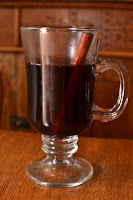Sense of Home Kitchen
Double Chocolate Pecan Cookies
~by Sense of Home Kitchen~
These chocolate cookies have a touch of cayenne pepper in them which enhances the chocolate flavor. If you want to be able to taste the cayenne, but not be overwhelmed by it, use 1/2 teaspoon rather than 1/4 teaspoon, either way they are good.
Makes about 3 dozen
1 1/2 cups all-purpose flour
3 tablespoons natural unsweetened cocoa powder
1/2 teaspoon baking soda
1/2 teaspoon salt
1/4 teaspoon cayenne pepper (use 1/2 teaspoon if you want to taste a little heat)
10 tablespoons (1 1/2 sticks) unsalted butter, softened
1/2 cup (packed) light brown sugar
1/3 cup granulated sugar
2 tablespoons plus 2 teaspoons light corn syrup
2 eggs
1 teaspoon vanilla extract
1 cup chopped pecans
1 cup semi-sweet chocolate chips
Preheat oven to 350°F.
In a small-sized bowl whisk together flour, cocoa powder, baking soda, salt, and cayenne pepper.
In a medium-sized bowl cream softened butter and brown sugar and sugar. Then add corn syrup, eggs and vanilla mixing well. Stir in flour mixture until just combined. Stir in pecans and chocolate chips.
Drop by rounded tablespoon onto ungreased baking sheet. Bake in preheated oven for approximately 9 minutes. Allow to cool on baking sheet for 2 minutes, then transfer to a cooling rack and allow to cool completely.
Store in an air-tight container. May be frozen to keep fresh for longer.
Sense of Home Kitchen / Recipes / Cookies and Bars
These chocolate cookies have a touch of cayenne pepper in them which enhances the chocolate flavor. If you want to be able to taste the cayenne, but not be overwhelmed by it, use 1/2 teaspoon rather than 1/4 teaspoon, either way they are good.
Makes about 3 dozen
1 1/2 cups all-purpose flour
3 tablespoons natural unsweetened cocoa powder
1/2 teaspoon baking soda
1/2 teaspoon salt
1/4 teaspoon cayenne pepper (use 1/2 teaspoon if you want to taste a little heat)
10 tablespoons (1 1/2 sticks) unsalted butter, softened
1/2 cup (packed) light brown sugar
1/3 cup granulated sugar
2 tablespoons plus 2 teaspoons light corn syrup
2 eggs
1 teaspoon vanilla extract
1 cup chopped pecans
1 cup semi-sweet chocolate chips
Preheat oven to 350°F.
In a small-sized bowl whisk together flour, cocoa powder, baking soda, salt, and cayenne pepper.
In a medium-sized bowl cream softened butter and brown sugar and sugar. Then add corn syrup, eggs and vanilla mixing well. Stir in flour mixture until just combined. Stir in pecans and chocolate chips.
Drop by rounded tablespoon onto ungreased baking sheet. Bake in preheated oven for approximately 9 minutes. Allow to cool on baking sheet for 2 minutes, then transfer to a cooling rack and allow to cool completely.
Store in an air-tight container. May be frozen to keep fresh for longer.
Sense of Home Kitchen / Recipes / Cookies and Bars

























































